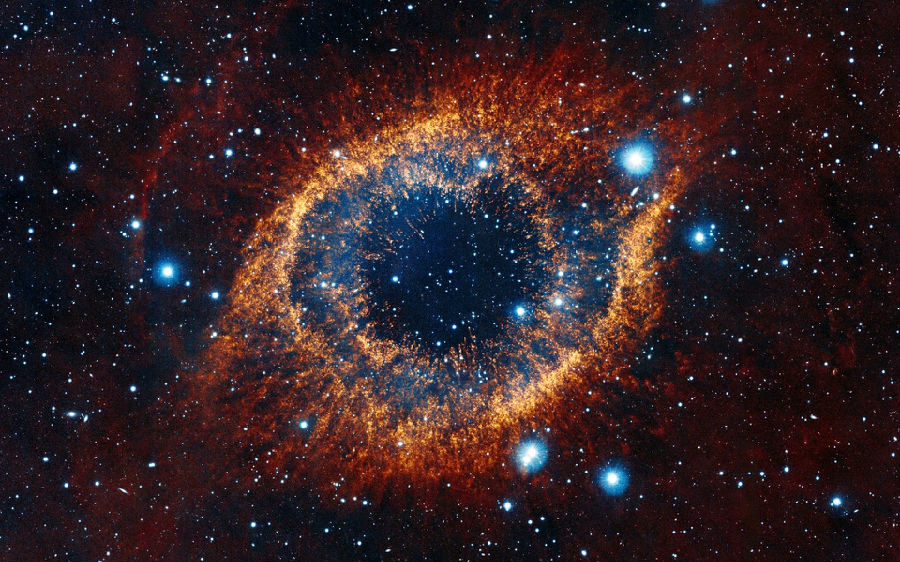The baby days of the universe were weird times.
宇宙初创时期环境十分怪异。
For hundreds of thousands of years after the Big Bang, it was too hot for even atoms to form, so everything in existence was just a soupy mess of particles.
即便是大爆炸发生数千年后,宇宙温度还是奇高,导致原子无法形成。故而当时宇宙里存在的一切事物都是一群粒子组成的乱码。
Eventually, things started to cool down, and particles could clump together to form hydrogen and helium,
后来,温度终于开始下降,粒子终于能结合形成氢和氦,
first as charged ions, and then as nice, neutral atoms.
开始是带电离子形式的氢和氦,后来演变为更好的形式:中性原子。
So it seemed like things were going to settle down. But then, the first stars showed up. And they kind of disrupted everything.
所以,看起来万事万物似乎都开始落定成型了,但那时候出现了第一批恒星,它们的出现可以说破坏了一切事物的节奏。
They turned all the neutral hydrogen floating around back into ions, created a bunch of new elements, and just generally made a mess.
这些恒星使宇宙中漂浮的所有中性氢原子变回了离子,又产生了许多新元素。总体上来说,把宇宙搞得一团乱。
But without them, you wouldn't be here.
但如果没有恒星,也就不会有你我
Astronomers think the first stars started to form as early as 30 million years after the Big Bang, when the universe was still made of neutral atoms.
一些天文学家认为,大爆炸后仅3000万年,就形成了第一批恒星,那时候宇宙里还都是中性原子。
Like stars today, they formed when clouds of gas collapsed, cramming atoms together so tightly that they fused.
跟今天的恒星一样,那时候的恒星也是在气体云坍缩时形成的,由于把原子挤压得太过紧密而出现了聚变。
These nuclear fusion reactions give off a ton of light and heat, and are what produce heavier elements and release the energy that powers stars.
核聚变反应会释放大量的光和热,还会产生质量更大的元素,并释放恒星运行所需的能量。
In the early universe, the gravity from dark matter is what originally pulled in those neutral hydrogen and helium atoms,
在初期的宇宙里,最初是暗物质的引力将这些中性氢原子和氦原子
gathering them into dense clumps and clouds.
聚集在一起,从而将它们变为高密度的云团。
We still aren't positive exactly what dark matter is, because we can't directly detect it,
我们尚不清楚暗物质究竟是什么,因为我们无法探测到暗物质,
but we do know that its gravitational pull helped make some parts of the early universe denser than others.
不过,我们知道暗物质是引力让宇宙初期的一些部分比其他部分密度更大。
Eventually, these clouds were so dense that they collapsed, and the atoms inside then began to combine in nuclear fusion reactions, forming stars.
最后,这些云团由于密度过高而坍缩,所以其中的原子开始在核聚变反应中聚合在一起,形成了恒星。
And suddenly, the universe was a whole lot brighter.
所以突然之间,宇宙就变得更亮了。
Those first stars were a lot different from the stars we see around us today.
宇宙初期的恒星与我们今天看到的地球周围的恒星还迥然不同。
For one, they were originally made only of hydrogen and helium because those were the only elements around.
一方面,他们一开始的组成元素只有氢和氦,因为那时候宇宙里也只有这两种元素。
All modern stars also contain heavier elements, like carbon,
现代所有的恒星中都包含质量更大的元素,比如碳,

that they've fused from lighter elements or collected from older, exploded stars.
这些大质量的元素要么是从质量较轻的元素聚变而来的,要么是从年代更为久远的恒星的爆炸残留物中得到的。
These heavier elements usually make stars cooler and smaller.
这些质量更大的元素通常会让恒星温度更低、体型更小。
That's because heavy elements tend to cool down clouds of gas, and it takes less mass for a cold cloud to collapse and form a star.
这是因为,大质量元素有个气体云降温的特性,而气体云温度越低,就越需要越少的质量来实现探索和形成恒星。
So if your gas cloud is full of heavier, cooler elements, it will form a star much faster than a cloud just made of hot hydrogen.
所以,如果气体云里充满了质量更大、温度更低的元素,其形成恒星的速度就会比仅由高温氢原子组成的气体云更快。
And because it took less stuff to form, the star will be smaller, too.
由于形成过程中用了更少的元素,所以形成的恒星体型也更小。
But with only hydrogen and helium around, the first stars were a lot larger and hotter than anything we see today.
不过由于一开始只有氢和氦两种元素,所以那时候的恒星无论是体型还是温度都比今天的更大更高。
They were probably 30 to 1000 times the mass of the Sun and up to three times as massive as any star we've ever found.
那时候恒星的质量大概是地球的30-1000倍,比目前所知的最大恒星的质量还要大两倍。
On their surfaces, they were about 15 times hotter than the Sun's surface at least twice as hot as the hottest star we know of.
那时候恒星的表面温度要比太阳表面的温度高近14倍,几乎是目前所知的温度最高的恒星的至少两倍。
They were actually so hot that they didn't give off that much visible light instead, they gave off powerful ultraviolet radiation.
由于温度过高,它们无法释放太多的可见光,相反它们放出的是紫外线辐射。
Like some kind of gigantic blacklight from the most extreme tanning bed ever.
有点儿像最晒的浴床所释放的强力不可见光一样。
And this radiation caused kind of a mess in the baby universe.
而且这种紫外线辐射造成了宇宙初期的一团乱麻。
The UV rays knocked some of the electrons off the neutral hydrogen atoms and maybe the helium ones, too turning them into charged ions again.
紫外线将使电子脱离了中性氢原子或许氦原子的境遇也是这样,将原子再次变为了带电离子。
A bubble of re-ionized atoms formed around each star and, as more stars formed, there were more re-ionized bubbles.
重新变为电子的一群原子聚集在每颗恒星周围。而随着更多恒星的形成,重新变为电子的粒子群也就更多了。
Eventually, over the next 900 million years, these bubbles all merged.
又过了9亿年,这些粒子群到处都是。
And once again, the gas spread all throughout the universe was made of ions except with some big, fiery stars this time.
所以,散布于宇宙各处的气体再次变为了离子的形式,只不过这一次宇宙里多了一些体型庞大,温度极高的恒星。
This period in history is called reionization, and it changed the universe for good.
历史上的这个时期名为再电离时期,这个时期永远地改变了整个宇宙。
Today, the gas that's floating around between galaxies known as the intergalactic medium, or IGM is still mostly made of ionized hydrogen.
今天,漂浮在星系之间的气体,又名星系际介质(IGM),基本上都是由氢离子组成的。
And it's all thanks to those first stars. But the stars did a lot more than knock the electrons off the gas in the IGM.
而这都归功于那第一批出现的恒星,但第一批出现的恒星所做的并非仅仅让电子脱离星系际介质中的原子气体而已。
As the years went on, they eventually did create heavier elements in their cores, as hydrogen or helium atoms were fused together.
随着时间的推移,恒星的内核还随着氢原子和氦原子的聚变而产生了质量更大的元素。
And because they were so hot, they probably created them a lot faster than today's stars.
而且由于其温度极高,所以很可能其产生新元素的速度要比今天的恒星更快。
Then, when the first stars exploded into the first supernovas, they flung those heavier elements like carbon and oxygen into the rest of the universe.
随后,当这第一批恒星爆炸形成第一批超新星时,将内核的大质量元素(比如碳和氧)散落到了宇宙中的其他地方。
Those atoms were incorporated into the new, smaller stars we see today as well as everything else,
这些大质量原子经过融合,进入了我们今天看到的体型更小的新恒星中
like comets and planets and moons and the screen you're using to watch this video.
此外,宇宙里的万事万物中也含有这些大质量原子,比如彗星、行星、月亮以及您用来观看这则视频的屏幕。
So basically, without those first stars, you wouldn't be here.
所以,基本上,如果没有这第一批恒星,就没有人类。
By learning more about exactly when and how reionization happened, scientists can learn even more about how it's influenced the universe.
如果能对再电离时期发生的时间和方式了解的更多,科学家还能对该时期是如何影响宇宙的方式了解得更多。
And as we build newer and even more powerful telescopes, they're hoping to find more answers.
此外,随着我们打造了更强大、更新的望远镜,或许我们能找到更多答案。
But there's one thing we know for sure: without the first stars, the universe would be completely different.
但有一件事情是肯定的:如果没有第一批恒星,今天的宇宙将是另一番景象。
It would still just be made of hydrogen and helium, and it would be really dark, which is a lot less exciting. And kind of sad.
会只有氢和氦,会黯然无光,这就显得了无生趣,让人有点提不起兴致。
So even though the first stars disrupted everything in the baby universe, we should probably be thankful that they did.
虽然第一批恒星破坏了宇宙初期的万事万物,但我们还是应该感谢它们的所作所为。
Thanks for watching this episode of SciShow Space!
感谢收看本期的《太空科学秀》!
If you'd like to keep learning more about the universe with us, you can go to youtube.com/scishowspace and subscribe.
如果您想和我们一起对宇宙了解更多,您可以登录并订阅youtube.com/scishowspace。











